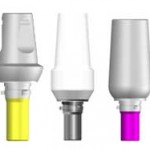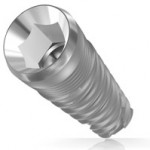There are many implants available, each designed for a specific function. Dental implant types can be categorized in different ways:
- By the type of connection on top of the head of the implant- internal/external hexagon, octagon, etc.
- By size- Wide, standard or narrow dental implants,
The standard implant is a cylindrical or screw type implant, called “root form”, is similar in shape to the root of a tooth with a surface area designed to promote good attachment to the bone. It is the most widely used design and generally placed where there is plentiful width and depth of jawbone. Where the jawbone is too narrow or short for immediate placement of root form implants the area may be enhanced with bone grafting to allow for their placement.
When the jawbone is too narrow and not a good candidate for bone grafting, a special narrow implant, called “plate form”, can be placed into the bone. In cases of advanced bone loss, the “subperiosteal” or wide implant, may be prescribed. It rests on top of the bone but under the gums.
- By the material used- Titanium, zircon. Most are made of titanium, an inert metal which has been proven to be effective at fusing with living bone, a process known as “osseointegration”
- By the stages of treatment- single stage or 2 stage
- and by Manufacturer.
The most common way to categorize dental implants is by the stages used during the dental implant procedure. The actual implant procedure involves the surgical placement of the implant or implants, a healing period (osseointegration) and implant restoration to replace the missing tooth or teeth. The treatment may be a cooperative effort between a surgical dentist who actually places the implant and a restorative dentist who designs, prescribes and inserts the final replacement teeth. Some dentists have advanced training and provide both of these services.
The 2 stage dental implants:
A 2 stage dental implant procedure begins with the surgery. In this surgical process the dental implant is fixed into the jaw bone. The implant is placed in the jaw bone and is screwed in all the way so that the top surface of the “screw†(implant) is at the same level of the bone.
The soft tissue is stitched up and a few months later the tissue has healed. There is no visible evidence of the implant in the bone as it is under the soft tissue and not visible to the eye.
During the next appointment, the dentist will perform a minor surgery where he will expose the top surface of the dental implant, connect a dental implant abutment and start the process of the dental implant restoration.
At the end of this appointment the patient will go home with the abutment in his mouth attached to the implant. Additional healing time is required, yet it is a short period and there is very little pain involved.
The single stage dental implants:
The single stage dental implant is designed in such a way that it enables avoiding the second surgery. During the single stage dental implant surgery, the implant is placed in the jaw bone in such a way that the top of the implant is higher than the surface of the bone and is actually at the height of the soft tissue (this is a longer implant).
When the soft tissue is stitched up at the end of the dental implant surgery the dental implant head is exposed and visible to the eye. After the healing time has passed there is no need for another surgery for exposing the top of the head of the implant because it is exposed to begin with and all the dentist needs to do is connect the dental implant abutment and start the restoration process.
Both dental implant types have the same success rate of 98% and it is usually up to the dentist to decide which type of dental implants to use. There is no big difference, essentially it’s just what the dentist is used to and feels comfortable working with.
If, for some reason, the dental implant dentist leaves the decision to you then you can choose either one but the one stage dental implant type is a bit shorter and a less painful procedure.
The type of dental implant Connection
While the progress of reconstructive and restorative dentistry has moved by leaps and bounds over the past decades, there are still heated debates around the ideal dental implant connection types. All of the major manufacturers have their preferred method for joining the screw to the replacement tooth. Some rule out one particular method because it may allow vibration or screw loosening, while others select their preferred dental implant connection type as a means of delivering a better pitch or angle to the replacement tooth. The major varieties include:
Internal Hex connectors – any kind of dental implant will require the “fusion†of the screw to the tooth, and the internal hex design is noted for providing a more natural appearance to the prosthetic tooth because the interior mechanism actually forces the tooth deeper into the connection. Additionally, this type of dental implant connection is considered a bit more stable, eliminating or reducing stress on the cold weld as well as any potential for rotation to occur. Some professionals suggest that positioning is a bit more flexible with the internal hex connectors, but that is a subject still under debate.
In addition to standard internal hex connectors there are also those enabled with a “friction fit†capability that completely eliminates any rotational capability of the devices. Currently some of the major dental implant system manufacturers using the internal hex connection types are Nobel Biocare, LifeCore and Zimmer.
External Hex connectors – the original format for all dental implant connection, external hex connection devices had to be modified to prevent rotation and improve stability. They were also frequently required to be “refitted†due to rotational issues. They are still in use widely, and some of the major dental implant companies include Biomet 3i, Bicon Dental Implants and Innova.
Internal Octagon connectors – The internal octagon connectors are considered one of the surest approaches to eliminating the adverse effects of force distribution on the prosthetic and the implant screw. The structures are thought to reduce fatigue over the long-term, and to allow for a stronger tightening procedure between the prosthetic and implant. Major producers of octagon connectors include Advance Dental and Nobel biocare.


